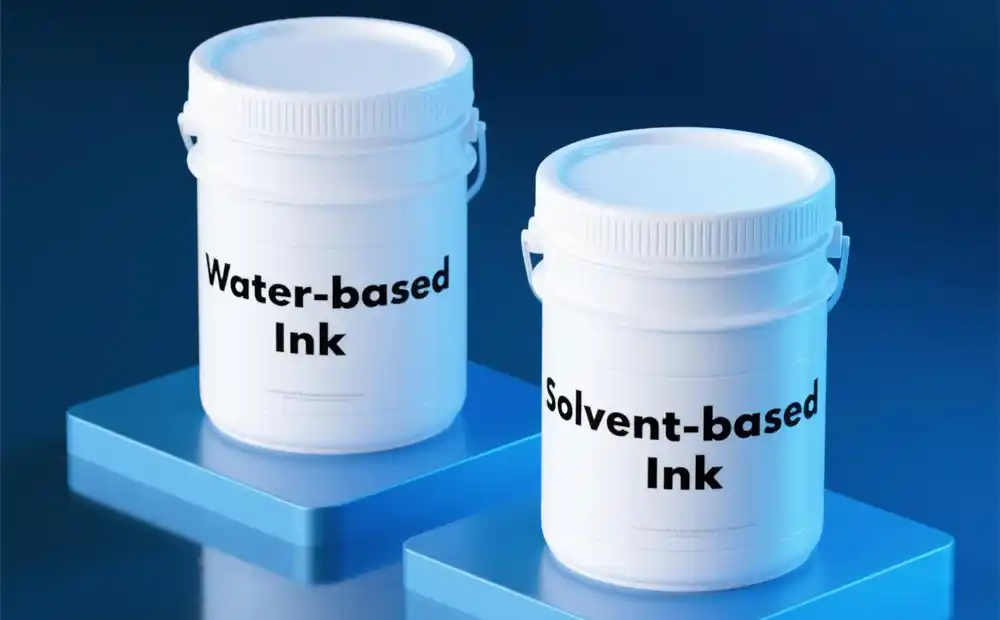Comparison of Water-based and Solvent-based Ink Formulations
Date: May 26 2025 From: Star Color Views:
The formulation designs of water-based inks and solvent-based inks form completely different component architectures due to their core solvents. This difference directly determines the physical and chemical properties, printing adaptability, and environmental attributes of the inks.
I. Comparison of Core Formulation Components
1. Solvent Systems: The Game Between Environmental Protection and Efficiency
| Component |
Water-based Ink |
Solvent-based Ink |
Technical Differences |
| Main Solvent |
Deionized water (60-80%) |
Ethyl acetate/toluene (50-70%) |
High polarity of water → poor wettability but near-zero VOCs |
| Co-solvent |
Propylene glycol methyl ether (5-15%) |
Isopropyl alcohol/butanone (10-20%) |
Adjust volatility rate and dissolving power |
| VOC Content |
≤50g/L |
300-500g/L |
Environmental regulations drive the substitution of water-based inks |
2. Comparison of Resin Systems
| Type |
Water-based Ink |
Solvent-based Ink |
Performance |
| Main Resin |
Water-based polyurethane dispersion (PUD, Tg -20~60℃) |
Chlorinated vinyl acetate resin/polyurethane (soluble in esters) |
Water-based resins require self-emulsifying modification |
| Curing Mechanism |
Water evaporation + self-crosslinking |
Solvent evaporation + oxidation polymerization |
Higher film density in solvent-based inks |
| Adhesion (PET) |
4B-5B (ASTM D3359) |
5B |
Water-based polyurethane approaches solvent-based performance on non-polar substrates |
Experimental Data:
- Water-based Polyurethane:
- Solid content: 30-40% (requires low-temperature drying)
- Peel strength: 5.2N/15mm (BOPP/CPP composite structure)
- Abrasion resistance: Weight loss ≤15mg/1000 cycles (Taber test, CS-10 wheel, 1kg load)
- Solvent-based Polyurethane:
- Solid content: 20-25% (high solvent proportion)
- Peel strength: 6.8N/15mm
- Abrasion resistance: Weight loss ≤10mg/1000 cycles
3. Comparison of Pigments and Dispersion Systems
| Component |
Water-based Ink |
Solvent-based Ink |
Technical Challenges |
| Pigment Type |
Alkali-resistant (stable at pH 8-9) |
Conventional organic/inorganic pigments |
Water-based systems require anti-flocculation treatment |
| Dispersant |
Polyacrylate (HLB 12-14) |
Phosphate esters (polar matching) |
Higher dosage of water-based dispersants (1-3%) |
| Grinding Process |
Nano sand grinding (zirconia beads 0.3mm) |
Three-roll grinding (particle size D50 1-5μm) |
Higher shear force required for water-based inks |
Actual Measurement Comparison: Carbon black water-based ink has D50=0.2μm (solvent-based: 0.5μm), but storage stability is 30% worse.
4. Comparison of Functional Additives
| Additive Type |
Water-based Ink |
Solvent-based Ink |
Mechanism of Action |
| Defoamer |
Polyether-modified siloxane (0.1-0.5%) |
Mineral oil-based (0.05-0.2%) |
Stronger defoaming needed due to high foam stability in water-based systems |
| Leveling Agent |
Fluorocarbon compounds (0.05-0.1%) |
Silicone-based (0.02-0.08%) |
Reduces surface tension differences |
| Preservative |
Isothiazolinone (0.1-0.3%) |
Not required |
Microbial growth prevention in water-based systems |
II. Performance Comparison Matrix of Formulations
| Index |
Water-based Ink |
Solvent-based Ink |
Root Cause of Gap |
| Drying Speed (25℃) |
2-5 minutes (requires hot air) |
0.5-2 minutes (natural evaporation) |
High latent heat of water evaporation (2257kJ/kg) |
| Water Resistance (24h immersion) |
3-4 grades (prone to blistering) |
Grade 5 (no change) |
Residual hydrophilic groups in resins |
| Printing Precision |
180-250LPI |
200-300LPI |
Slightly lower fluidity in water-based inks |
| Storage Stability |
6-12 months (anti-freezing required) |
18-24 months |
Tendency to phase separate/mildew in water-based systems |

III. Analysis of Typical Formulation Cases
1. Water-based Plastic Ink Formulation
| Component |
Proportion |
Function |
| Water-based acrylic resin |
35% |
Film formation/adhesion |
| Phthalocyanine blue pigment |
12% |
Color development |
| Propylene glycol methyl ether |
8% |
Reduces surface tension |
| Polyurethane thickener |
0.8% |
Thixotropy control |
| Bactericide |
0.2% |
Anticorrosion |
Performance Parameters: Viscosity 35s (coating cup #4), adhesion 4B, VOC 42g/L
2. Solvent-based Composite Ink Formulation
| Component |
Proportion |
Function |
| Chlorinated vinyl acetate resin |
25% |
Heat-resistant/high adhesion |
| Benzidine yellow pigment |
15% |
High covering power |
| Ethyl acetate |
45% |
Fast-drying solvent |
| Polyethylene wax |
1.5% |
Anti-scratch |
| Dispersant |
2% |
Pigment stabilization |
Performance Parameters: Viscosity 22s (coating cup #4), adhesion 5B, VOC 380g/L
The formulation differences between water-based inks and solvent-based inks essentially represent a trade-off between environmental protection and performance. Water-based systems are gradually breaking through bottlenecks through resin modification and nanotechnology, while solvent-based inks remain irreplaceable in special fields due to their mature processes. Over the next decade, the two will coexist long-term, evolving dynamically in the game between "low-carbon regulations" and "performance needs."
 RU
RU
 EN
EN
 CN
CN

